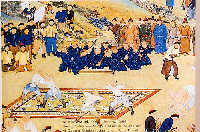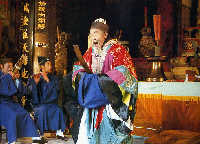 Court Music
Court Music

There is a record about music in "Yugua in Tijing: "Emperors in ancient times eulogized virtues with music and made sacrifice to the God with magnificent music." Since the beginning of the Chinese nation, virtually all the dynasties have had the tradition that emperors eulogized virtues with music; therefore, court music is a national music with rich historical connotations. Since the establishment of the system of "music under government control" in the Northern Wei Dynasty, most of court musicians are from this system, which is especially obvious in the Ming andQing DynastyThat is to say, court is a place not only for the development and spreading of folk music, and court music is the flowering and polishing of folk music. As a result, Beijing Volume, Hebei Volume and Inner Mongolia Volume include some numbers of court music.
 Sacrificial Music
Sacrificial Music

There are descriptions for folk sacrificial scenes of dancing and singing in "Donghuang taiyi" and "Dongjun" of Jiuge byQu Yuan(a great ancient Chinese poet). For a long time, people like to highlight ethnic and tribal cultures with ritual music so as to achieve the effect of mystery and shock. Inner Mongolia Volume and Heilongjiang Volume include Shamanist sacrificial music, which reflect the characteristics of local sacrificial music cultures of Mongolia ethnic group, Dawoer ethnic group, Ewenke ethnic group, Elunchun ethnic group and Hezhe ethnic group. Hunan Volume and Guizhou Volume also include music for sacrificial ritual and religious ceremonies, which reflect the local customs of communication between man and god, and the customs of making sacrifice to spirits. Shandong Volume, Beijing Volume and Hunan Volume  include some numbers of music for sacrifice toConfucius, which reflect the fact that Chinese people of different times have placed a stress on Confucian culture.
include some numbers of music for sacrifice toConfucius, which reflect the fact that Chinese people of different times have placed a stress on Confucian culture.
 Religious music
Religious music
The collection includes a lot of music numbers ofBuddhism, Taoism and Islam, from which we can know their basic styles, for there is rich cultural information in the three religions.










